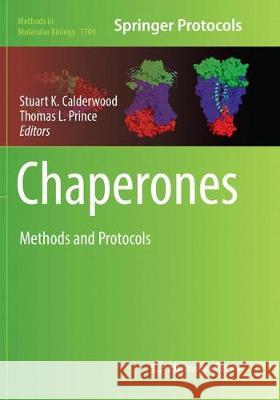Chaperones: Methods and Protocols » książka



Chaperones: Methods and Protocols
ISBN-13: 9781493984985 / Angielski / Miękka / 2018 / 445 str.
Chaperones: Methods and Protocols
ISBN-13: 9781493984985 / Angielski / Miękka / 2018 / 445 str.
(netto: 460,04 VAT: 5%)
Najniższa cena z 30 dni: 462,63
ok. 22 dni roboczych
Dostawa w 2026 r.
Darmowa dostawa!
1. Targeted Deletion of Hsf1, 2 and 4 Genes in Mice
Xiongjie Jin, Binnur Eroglu, Demetrius Moskophidis, and Nahid F. Mivechi
2. Role of Heat Shock Factors in Stress-induced Transcription
Murshid, A., Prince T., Ben Lang, and Calderwood, S. K.
3. Monitoring of the Heat Shock Response with a Real-time Luciferase Reporter
Toshiki Kijima, Takanori Eguchi, Len Neckers, and Thomas L. Prince
4. Quantitative Profiling of Chaperone/client Interactions with LUMIER Assay
Mikko Taipale
5. Measurement of chaperone-mediated effects on Polyglutamine Protein Aggregation by the Filter Trap Assay
Maria A.W.H. van Waarde-Verhagen and Harm H. Kampinga
6. Fluorescent-linked Enzyme Chemoproteomic Strategy (FLECS) for Identifying HSP70 Inhibitors
Haystead, T.A.J.
7. A High-throughput Screen for Inhibitors of the Hsp90-Chaperone Machine
Jason Davenport, Lakshmi Galam, and Robert L. Matts
8. Primary Colorectal Cells Culture as a Translation Research Model
Sheah Lin Lee, Nina Claire Dempsey-Hibbert, Dale Vimalachandran, Terence David Wardle, Paul A Sutton, and John H. H. Williams
9. Cell Death and Survival Assays
Alexander E. Kabakov and Vladimir L. Gabai
10. Detecting the Potential Pharmacological Synergy of Drug Combination by Viability Assays In Vitro
Benjamin K. Gibbs and Carole Sourbier
11. Proteomic Profiling of Hsp90 Inhibitors
Sudhakar Voruganti, Jake T. Kline, Maurie J. Balch, Janet Rogers, Robert L. Matts, and Steven D. Hartson
12. Analysis of HspB1 (Hsp27) Oligomerization and Phosphorylation Patterns and its Interaction with Specific Client Polypeptides
André-Patrick Arrigo
13. Nucleotide Exchange Factors for Hsp70 Chaperones
Heike Rampelt, Matthias P. Mayer, and Bernd Bukau
14. Determination of Hsp90 Activity through Activation of Glucocorticoid Receptors in Yeast
Michael Reidy
15. Bacterial Hsp90 ATPase Assays
Joel R. Hoskins, Sue Wickner, and Shannon M. Doyle
16. Detecting Post-translational Modifications of Hsp90
Rebecca A. Sager, Mark R. Woodford, Len Neckers, and Mehdi Mollapour
17. Chromatin Immunoprecipitation (ChIP) of Heat Shock Protein 90 (Hsp90)
Aneliya Yoveva and Ritwick Sawarkar
18. A Workflow Guide to RNA-seq Analysis of Chaperone Function and Beyond
Benjamin J. Lang, Kristina M. Holton, Jianlin Gong, and Stuart K. Calderwood
19. Computational Modeling of the Hsp90 Interactions with Cochaperones and Small Molecule Inhibitors
Gennady M. Verkhivker
20. Computational Analysis of the Chaperone Interaction Networks
Shwani Kumar, Kamran Rizzolo, Sandra Zilles, Mohan Babu, and Walid A. Houry
21. Immunohistochemistry of Human Hsp60 in Health and Disease: From Autoimmunity to Cancer
Francesco Cappello, Everly Conway de Macario, Francesca Rappa, Giovanni Zummo, and Alberto J. L. Macario
22. Immunohistochemical and Flow Cytometric Analysis of Intracellular and Membrane-bound Hsp70, as a Putative Biomarker of Glioblastoma Multiforme, using the cmHsp70.1 Monoclonal Antibody
Stefan Stangl, Gemma A. Foulds, Helena Fellinger, Geoffrey J. Pilkington, A. Graham Pockley, and Gabriele Multhoff
23. Detection and Analysis of Extracellular Hsp90 (eHsp90)
Stephanie Cortes, Alexander Baker-Williams, Mehdi Mollapour, and Dimitra Bourboulia
24. Molecular Chaperone Receptors
Ayesha Murshid, Jimmy Theriault, Jianlin Gong, and Stuart K. Calderwood
25. Creation of Recombinant Chaperone Vaccine using Large Heat Shock Protein for Antigen-targeted Cancer Immunotherapy
Chunqing Guo, John R. Subjeck, and Xiang-Yang Wang
26. A Novel Heat Shock Protein 70-based Vaccine Prepared from DC-Tumor Fusion CellsDesheng Weng, Stuart K. Calderwood, and Jianlin Gong
27. Hsp70: A Cancer Target Inside and Outside the CellChristophe Boudesco, Sebastien Cause, Gaëtan Jego, and Carmen Garrido
28. Evidence for Hsp90 Cochaperones in Regulating Hsp90 Function and Promoting Client Protein Folding
Marc B. Cox and Jill L. Johnson
29. Clinical Evaluation and Biomarker Profiling of Hsp90 Inhibitors
Akira Yuno, Min-Jung Lee, Sunmin Lee, Yusuke Tomita, David Rekhtman, Brittni Moore, and Jane B. Trepel
This volume is a compilation of laboratory protocols and methodology required for the study of molecular chaperones and the cellular stress response. Chapters detail stress response in Hsf1, Hsf2 and Hsf4 knockout mice, mapping HSP interaction networks, the LUminescence-based Mammalian IntERactome (LUMIER), Hsp70 biology, protein folding activity of Hsp90, cytotoxicity of HSP inhibitors, computational approaches for modeling allosteric Hsp90 interactions, HSPs in immunity and vaccine development , and biologies of Hsp70 and Hsp90. Written in the highly successful Methods in Molecular Biology series format, chapters include introductions to their respective topics, lists of the necessary materials and reagents, step-by-step, readily reproducible laboratory protocols, and tips on troubleshooting and avoiding known pitfalls.
1997-2025 DolnySlask.com Agencja Internetowa
KrainaKsiazek.PL - Księgarnia Internetowa









